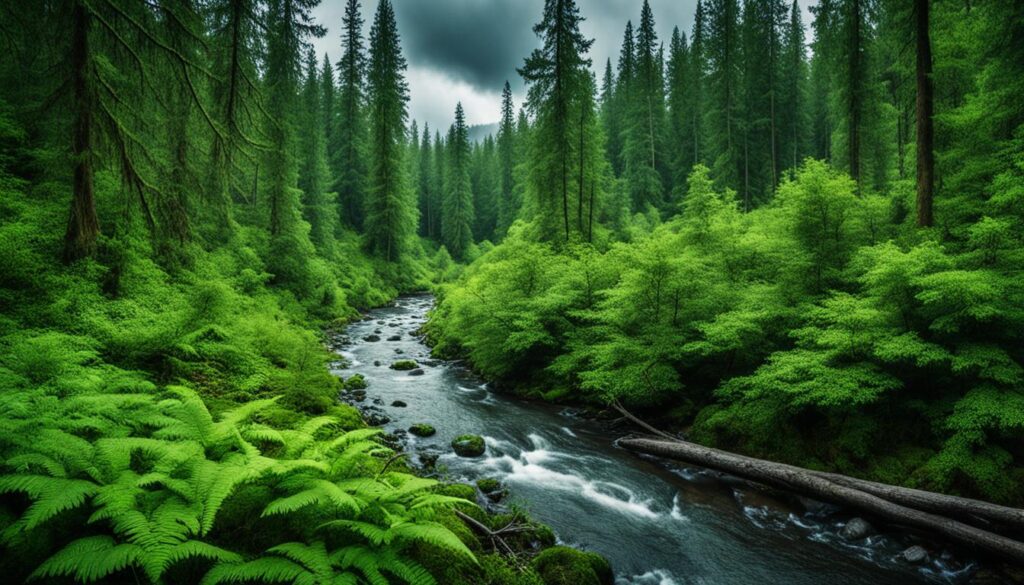Forests are like the lungs of our planet, crucial for our environment’s health. They produce oxygen and store carbon, which are key for life on Earth. These green spaces also offer many services that help us live.
It’s vital to protect our forests from threats like deforestation. This article will show why saving forests is so important. We’ll see how they help with the climate, support life, and keep our planet healthy.
Forests manage the water cycle and prevent soil erosion. They are homes for many plants and animals. As we face climate change, forests are more important than ever in fighting its effects.
We can protect forests through sustainable management and global efforts. Let’s learn how we can help save these vital natural areas. Join us in understanding the importance of forests and how we can protect them.
Forests: The Lungs of Our Planet
Forests are called the “lungs of the Earth” because they are key to making oxygen and storing carbon. These green areas are full of trees and plants that make oxygen by taking in carbon dioxide. This helps keep our air clean and shows why forests are crucial for our planet.
Oxygen Production and Carbon Sequestration
Forests are essential for our atmosphere’s balance. They take in carbon dioxide and turn it into food, removing it from the air. At the same time, they release oxygen, which is vital for all living things. This shows how forests and our atmosphere are connected.
Habitat for Biodiversity
Forests are more than just good for making oxygen and storing carbon. They are also homes for many plants and animals. These places support life on Earth and keep our ecosystems healthy. From big trees to small creatures, forests are full of life, which is key for our planet’s health.
Ecosystem Services Provided by Forests
Forests are more than just beautiful landscapes. They provide essential services crucial for our health and the planet’s well-being. These services include managing the water cycle, preventing soil erosion, filtering air and water, offering food and medicine, and supporting fun and cultural activities.
Forests are key in regulating the water cycle. They soak up rain and slowly release it, preventing floods and ensuring clean water for people. They also stop soil erosion, which protects our land and keeps our water clean.
Forests are great at cleaning the air and water. Trees and plants take in pollutants and give out oxygen, vital for life. They also clean water by removing dirt and harmful substances, keeping our drinking water safe.
Forests give us food and medicine too. Many communities depend on them for survival and traditional healing. They also offer places for recreation and cultural activities, like hiking and camping.
Protecting our forests is key to keeping these services going for future generations. Forest conservation is vital for our planet and for the health of communities worldwide.
The Role of Forests in Climate Change Mitigation
Forests are more than just beautiful places. They are key in fighting climate change. They soak up and store carbon dioxide, which helps balance the Earth’s air and cuts down on global warming gases.
Regulating the Water Cycle
Forests also play a big part in the water cycle. They manage water flow, stop soil erosion, and keep watersheds healthy. This way, they lessen the effects of droughts and floods, which climate change makes worse.
Preventing Soil Erosion
Tree roots hold the soil in place, keeping it from being washed or blown away. This keeps the soil fertile and supports the ecosystems that need it. Healthy soils are key for absorbing and storing carbon, making forests vital in fighting climate change.
By saving forests and using them wisely, we boost their ability to fight climate change. This is why saving forests is crucial for the planet and for our future.

Threats to Forests: Deforestation and Degradation
Forests are vital for life on Earth but face threats like deforestation and degradation. Deforestation means cutting down forests for other uses. It has big effects. The main causes are farming, building cities, logging, and mining.
Causes of Deforestation
Agriculture is a big reason for deforestation. More people mean more food and land needs. This leads to forests being turned into farms. Urban growth is another cause, as cities and buildings take over forests.
Logging, both legal and illegal, also harms forests. Unsustainable timber taking leaves forests bare and weak. Mining for minerals destroys forest homes too.
Consequences of Deforestation
Deforestation has big problems. It hurts biodiversity and messes with the water cycle. This can cause soil erosion, floods, and droughts. It also adds to climate change by releasing stored carbon.
We must fight deforestation to save our planet’s forests. Knowing why it happens and how to stop it is key. We need to protect forests for their many benefits.
Sustainable Forest Management Practices
Sustainable forest management is key to saving our planet’s forests. It balances economic, social, and environmental benefits. This way, forests can keep thriving for a long time.
Selective logging is a main practice. It means taking out certain trees without cutting down the whole area. This keeps the forest healthy and diverse. Reforestation is also vital, where we plant native trees on lands that were once forests.
Managing fires well is also important. Controlled burns and other steps help prevent big wildfires. Protecting old-growth forests is crucial too. These areas are full of life and offer important services to the ecosystem.
By using these practices, we can keep our forests healthy. They give us resources and protect nature. Sustainable forestry is a way to fight deforestation and save our forests for the future.
Nature and Its Impact on Human Well-being
Forests and natural areas are key to our planet’s health and our well-being. Studies show that being in nature can make us feel better, both in our minds and bodies. It lowers stress, lifts our mood, and gets us moving.
By saving forests and nature spots, we help ourselves and our communities feel better. Nature’s beauty is just the start. It deeply affects our mental and physical health.
Being in nature cuts down stress and anxiety, makes us happier, and sharpens our minds. It also gets us active, which is good for our hearts and overall health. Plus, nature’s calmness can ease depression and anxiety.

Forests and humans have a special bond. Saving nature helps our planet and boosts our communities’ health. By protecting forests and nature, we learn to value and enjoy the natural world. This improves our mental and physical health.
Indigenous Communities and Forest Conservation
Indigenous communities have always been key in protecting the forests they live in. They have a deep connection to the land and know how to take care of it. This knowledge helps them manage the forests in a way that keeps them healthy for the future.
These communities see forests as more than just resources. They view themselves as guardians of the land. They work to keep the forests healthy for their children and grandchildren. This approach helps protect the forests from threats like deforestation and climate change.
Traditional Ecological Knowledge
Indigenous communities have a special kind of knowledge about the forests. This knowledge has been passed down for generations. It includes understanding the local environment, animal behavior, and the relationships between plants and animals.
This knowledge helps them manage the forests in a way that works best for the ecosystem. It’s a key part of their efforts to protect and restore forests. By working with these communities, we can make conservation efforts more effective and sustainable.
Economic Benefits of Forest Conservation
Forests are vital for our planet’s health and offer big economic benefits. They are more than just sources of timber. They support thriving economies, create jobs, and help communities prosper.
The forestry industry shows how forests help the economy. By managing forests sustainably, companies can take timber without harming the environment. This way, they support the industry and keep forests valuable for clean air and water.
Forests also bring in money through ecotourism, non-timber products, and carbon sequestration. Ecotourism is growing fast, attracting visitors to forests’ beauty and diversity. This shows how forests boost local economies and make regions richer.
As we learn more about forests fighting climate change and supporting sustainable development, their economic value grows. Investing in forests means protecting them and helping communities thrive for the future.
Global Efforts and Initiatives for Forest Conservation
Forests are crucial for our planet’s health, so many global efforts aim to protect and restore them. Groups like the World Wildlife Fund, The Nature Conservancy, and Conservation International lead the way. They work with governments, communities, and businesses to use forests wisely and keep them safe.
International agreements, such as the UN Sustainable Development Goals and the Paris Agreement, focus on forests too. These agreements help countries share knowledge and work together to protect forests worldwide.
There are many ways to help, from local projects that support indigenous people to big efforts to plant more trees. Everyone is working together to keep the world’s forests healthy and strong. With the help of many groups, we can make a big difference and protect our planet’s forests for the future.







